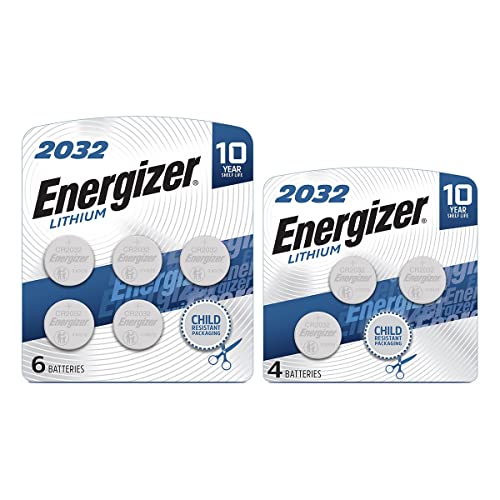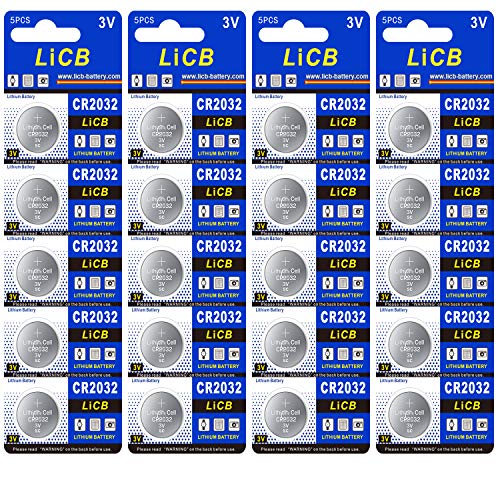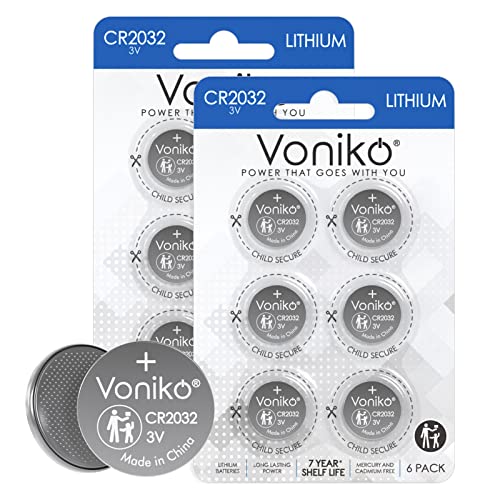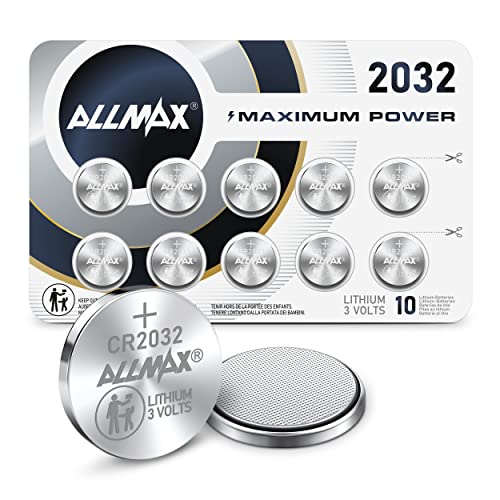
When it comes to finding the best CR2032 batteries, it's important to consider factors like longevity and reliability. The 10 Best CR2032 Batteries are those that offer a long lifespan and consistent performance, making them ideal for a wide range of devices. From small electronic gadgets to medical devices, these top 10 CR2032 batteries are known for their durability and high-quality design. Whether you're looking for a replacement battery for your car key fob or a backup for your favorite watch, these top 10 CR2032 batteries are sure to meet your needs.
Overall Score: 9/10
The Energizer 2032 Batteries, Lithium CR2032 Watch Battery Combo Pack is a ten-pack of 3V lithium coin batteries that function in extreme temperatures and have a shelf life of up to 10 years. These long-lasting batteries are suitable for toys, health monitors, garage door openers, wireless keyboards, Apple AirTags, Garmin bike computers, and various other tools. They come in child-resistant packaging and are highly reliable, outperforming generic no-name batteries. Customers have reported great value and longevity, with some stating that they find it more cost-effective to invest in these high-quality Energizer batteries rather than cheaper alternatives.
Key Features
- 10 Count of Energizer 2032 Batteries, 3V Lithium Coin Batteries
- Performs in extreme temperatures from -22 F to 140 F
- Long-lasting toy, health monitor, and remote batteries
- Coin cell batteries hold power for up to 10 years in storage
- Enclosed in child-resistant packaging
Specifications
- Size: 10 Count (Pack of 1)
Pros
- High value and long-lasting
- Reliable and safe for kids
- Cost-effective in the long run
Cons
- Higher price tag compared to alkaline batteries
The Energizer 2032 Batteries Combo Pack is a reliable, long-lasting, and safe option for a wide range of devices, offering great value for money and peace of mind. However, the initial cost may be higher compared to generic batteries, but the superior performance and longevity make it a worthwhile investment.
Overall Score: 9/10
The Duracell CR2032 3V Lithium Battery is designed for dependability, safety, and long-lasting power. It features bitter taste discouragement to prevent swallowing, child-secure packaging, and a guarantee for 10 years in storage. This 6-count pack provides reliable power for key fobs, car remotes, glucose monitors, and more. With a customer rating of 4.7/5, this product has received positive reviews for its long-lasting performance and child safety features. However, some users have had difficulty opening the packaging. Overall, the Duracell CR2032 3V Lithium Battery is the top choice for those seeking reliable and long-lasting power for their electronic devices.
Key Features
- Bitter taste discourages swallowing
- Child-secure packaging
- Long-lasting power and performance
- Reliable power for various devices
- Guaranteed for 10 years in storage
- 1 trusted battery brand
Specifications
- Color: Silver
- Dimension: 0.19Lx3.75Wx4.50H
- Size: 6 Count (Pack of 1)
Pros
- Long-lasting power
- Child safety features
- Trusted brand name
- Reliable for key fobs and remotes
Cons
- Difficulty opening packaging
The Duracell CR2032 3V Lithium Battery offers exceptional reliability and child safety features. With long-lasting power and a trusted brand name, it is the ideal choice for powering electronic devices. While some users have faced challenges with the packaging, the battery’s performance and safety features make it a top recommendation for everyday use.
Overall Score: 9/10
The LiCB CR2032 Battery is a high-quality, long-lasting 3V coin and button cell lithium battery. It comes in a pack of 20 and has been tested under strict quality control standards. The batteries have a shelf life of 3 years and are primarily used in various devices including watches, computer motherboards, calculators, toys, and medical devices. They are CE and ROHS certified, ensuring superior safety. The batteries are compatible with Energizer, DL2032, and other similar models. Each pack comes in an exact blister pack, providing great value for the price.
Key Features
- High Quality: Tested under Strict Quality Control Standards. CE and ROHS Certified. Grade A cells CR2032 Ensure Longer Battery Life and Long Lasting Power
- Contains Exact Fresh CR2032 Batteries, with Full 3 Volts Charge and 3 Years Shelf Life
- Versatile: Primarily used in a wide range of devices including watches, calculators, toys, and medical devices
- Compatibility: Compatible with various battery models including Energizer CR2032, KCR2032, and more
- Pack Includes: 20 PCS CR2032 Batteries in Exact Blister Pack
Specifications
- Size: 20 Pack
Pros
- Good value for the price
- Long shelf life of 3 years
- Compatible with various devices and battery models
- Comes in a convenient 20-pack
- CE and ROHS certified for superior safety
Cons
- Life of battery may not be very long for certain devices
The LiCB CR2032 Battery is a cost-effective, long-lasting option for powering a variety of devices including watches, toys, and medical devices. With a shelf life of 3 years and compatibility with various devices, it provides great value for the price. While it may not be suitable for devices with very high power requirements, it is a reliable choice for everyday devices.
Overall Score: 8/10
The Voniko 3 Volt CR2032 Battery 12 Pack is a reliable and safe option to power various devices such as watches, computer motherboards, calculators, and more. It comes in child-resistant packaging and boasts a 7-year storage life, making it a convenient choice for long-term use. With double corrosion protection, these batteries are leak-free and safe to use. However, some users have reported intermittent performance for certain devices. Overall, Voniko offers a high-quality and durable option for powering everyday devices.
Key Features
- Child-Resistant Packaging
- Maintains 7 Years Storage Life
- Power Watches, Computers, And More
- Reliable, Safe, Leak-Free
- Double Corrosion Protection
Specifications
- Dimension: 5.67Lx3.68Wx0.47H
- Size: 1 Count (Pack of 12)
Pros
- Comes in child-resistant packaging
- Long 7-year shelf life
- Reliable and leak-free operation
- Double corrosion protection
Cons
- Intermittent performance for some devices
The Voniko 3 Volt CR2032 Battery 12 Pack provides long-lasting, reliable power for a variety of devices. With child-resistant packaging, 7-year storage life, and double corrosion protection, it offers peace of mind and convenience. While some users have reported intermittent performance, the overall quality and durability make it a solid choice for everyday use.
Overall Score: 9/10
The Panasonic CR2032 3.0 Volt Long Lasting Lithium Coin Cell Batteries come in a pack of 4. They are designed to provide reliable power for small electronic devices such as digital watches, car keys, fitness appliances, and medical devices. These batteries have a long shelf life of up to 8 years and are engineered to be reliable even in a wide range of operating temperatures. The packaging and batteries meet or exceed industry compliance standards, making them a safe and trustworthy choice. The 3.0V nominal voltage ensures consistent performance, and they are proudly made by Panasonic in their Indonesia manufacturing facility.
Key Features
- Engineered to provide reliable long lasting power
- Reliable even in a wide range of operating temperatures
- Meet or exceed industry compliance standards
- Long shelf life of up to 8 years
- 3.0V nominal voltage
- Proudly made by Panasonic in Indonesia
Specifications
- Dimension: 0.78Lx0.78Wx0.12H
- Size: 1 Count (Pack of 4)
Pros
- Reliable and long-lasting power
- Meets industry compliance standards
- 3.0V nominal voltage for consistent performance
- Proudly made by Panasonic
- Long shelf life of up to 8 years
Cons
- May not fit all devices
The **Panasonic CR2032 3.0 Volt Long Lasting Lithium Coin Cell Batteries** offer reliable and long-lasting power for a variety of small electronic devices. They meet industry compliance standards and have a long shelf life, making them a trustworthy choice for powering your devices. However, they may not fit all devices, so it’s important to check compatibility before purchasing.
Overall Score: 8/10
The Panasonic One (1) Twin Pack (2 Batteries) CR2032 Lithium Coin Cell Battery 3V is a reliable and long-lasting option for a wide range of electronic devices. With a nominal voltage of 3.0V and a long shelf life of up to 8 years, these batteries offer dependable power. They are designed to be reliable in various operating temperatures and meet compliance standards. The 2-count pack provides good value, making it a convenient option for anyone in need of a replacement battery for their devices.
Key Features
- Reliable even in a wide range of operating temperatures (-22°F to +140°F)
- Meets or exceeds compliance standards
- Long shelf life of up to 8 years
- 3.0 V nominal voltage
Specifications
- Dimension: 0.79Lx0.79Wx0.05H
- Size: 2 Count (Pack of 1)
Pros
- Reliable performance in various devices
- Meets compliance standards
- Convenient 2-count pack for value
Cons
- Batteries can be expensive
- Packaging could be improved
The Panasonic CR2032 Lithium Coin Cell Battery offers reliable performance and longevity for various devices. While the pricing and packaging could be improved, the overall value and convenience of the 2-count pack make it a practical choice for those in need of replacement batteries. With its dependable power and compliance with standards, it is a solid option for consumers looking for high-quality batteries.
Overall Score: 9/10
The LiCB CR2032 3V Lithium Battery(10-Pack) offers a high-quality, 3V charge with a 3-year shelf life. These button cell batteries are versatile and are suitable for various devices such as watches, electronic organizers, garage door openers, toys, and more. They have a long-lasting power supply and provide convenience through their bulk pack. Users have noted that these batteries are reliable, experience no leaks, and are ideal for applications like AirTags. While they may have a slightly shorter lifespan compared to premium options, their affordability makes them a worthwhile purchase.
Key Features
- High Quality: Tested under Strict Quality Control Standards
- 3V charge with a 3-year shelf life
- Versatile usage for various devices
- Exact Fresh CR2032 Batteries in Exact Blister Pack
- No leaks and reliable performance
Specifications
- Color: Cr2032 10pack
- Size: 10 Count (Pack of 1)
Pros
- Long-lasting and reliable power supply
- Bulk pack for convenience and affordability
- No leaks and reliable performance
- Compatibility with Air Tags
Cons
- Slightly shorter lifespan compared to premium options
- Packaging can be difficult to open
The LiCB CR2032 3V Lithium Battery(10-Pack) offers impressive quality and performance at an affordable price point. With reliable power, long-lasting charge, and a versatile range of applications, these button cell batteries provide excellent value for users. While they may not match the longevity of premium alternatives, the balance between cost and functionality makes them a sensible choice for a variety of devices.
Overall Score: 9/10
The Allmax CR2032 Maximum Power Lithium Coin 3V Battery is a high-performance premium grade battery designed for maximum power and ultra-long-lasting performance. With a leakproof design and 10-year shelf life, these batteries are perfect for a wide range of electronic devices, including Apple Remotes, watches, calculators, medical devices, key fobs, and more.
Key Features
- Maximum Power with 240 m Ah
- Ultra Long-Lasting
- Leakproof Design
- 10-Year Shelf Life
- Compatible with a wide range of electronic devices
Specifications
- Dimension: 7.09Lx4.53Wx0.18H
- Size: 10 Count (Pack of 1)
Pros
- High performance and long-lasting
- Leakproof design
- 10-year shelf life
- Compatible with various electronic devices
Cons
- No significant cons reported
The Allmax CR2032 coin batteries offer maximum power, long-lasting performance, and a leakproof design, making them a reliable choice for various electronic devices. With a 10-year shelf life and compatibility with a wide range of devices, these batteries provide excellent value for households, schools, and businesses alike.
Overall Score: 9/10
The Panasonic CR2032 3.0 Volt Long Lasting Lithium Coin Cell Batteries come in a child resistant, standards based packaging. Perfect for a wide range of household devices, these batteries provide dependable power, have a long storage life, and work well in extreme temperatures. They are made by Panasonic and comply with safety standards. These batteries are great for car key FOBs, watches, calculators, garage door openers, toys, and many other devices.
Key Features
- Long lasting performance
- Child resistant safety standards based packaging
- Long storage life
- Dependable power in extreme temperatures
- Powerful cr2032 batteries
- Hundreds of household devices
- Made by panasonic
- Package contents
Specifications
- Color: Silver
- Dimension: 0.78Lx0.78Wx0.12H
- Size: 1 Count (Pack of 2)
Pros
- Long lasting
- Quick delivery
- Great value for the money
- Work great for BMW key-FOB
- Great for car keys
- Dependable brand
- Great value in package of two
Cons
- No specific cons mentioned
The Panasonic CR2032 batteries are a reliable and long-lasting option for various household devices. With a high customer rating and positive reviews, they provide great value for money. The child resistant, standards based packaging ensures safety and compliance. Overall, these batteries are a dependable choice for anyone in need of power for their devices.
Overall Score: 9/10
Maxell Micro Lithium Cell CR2032 is a pack of 5 3-volt 90 mAh lithium batteries, made in Japan. They have a fresh expiration date and are highly rated for lasting 7-12 months, ideal for car keys and Bluetooth devices. Customers find them to be a good value, high quality, and long-lasting. These batteries are perfect for everyday use and offer great value for your money.
Key Features
- High Quality Made in Japan
- New batteries with fresh dated expiration date
- Maxell CR-2032 3 Volt 90 m Ah Lithium Battery
Specifications
- Dimension: 0.78Lx0.78Wx0.12H
- Size: 5 Count (Pack of 1)
Pros
- Good value for your money
- Works and made in Japan
- Long lasting – 7-12 months
- Great quality and long-lasting
Cons
- Cracked under severe conditions
Maxell Micro Lithium Cell CR2032 batteries are a highly rated, long-lasting, and good value product that customers love. Made in Japan, these batteries have received positive feedback for their reliability and durability, making them ideal for a variety of electronic devices. With a high customer rating and positive reviews, these batteries are a great choice for anyone in need of reliable power at an affordable price.
- Consider the Size and Shape: Make sure the 2032 battery fits the device you’re using it for, and that it’s the right shape (some are flat, some are button-shaped).
- Check the Voltage: Different devices require different voltage for batteries. Make sure the 2032 battery you choose has the right voltage for your device.
- Look for the Right Capacity: The capacity of a 2032 battery determines how long it will last. Higher capacity batteries will last longer, but may be slightly larger.
- Brand Reliability: Some brands are known for making high-quality batteries that last longer and perform better. Research different brands to find the most reliable one.
- Expiration Date: Check the expiration date on the battery to make sure it’s fresh and will last a long time.
- Environmentally Friendly: Look for eco-friendly options, such as rechargeable 2032 batteries, to reduce waste and environmental impact.
- Price Comparison: Compare prices from different retailers to ensure you’re getting the best deal on your 2032 batteries.
- Product Reviews: Read reviews from other buyers to get an idea of the performance and reliability of the specific 2032 battery you’re considering.
- Warranty and Guarantees: Some brands offer warranties or guarantees on their batteries, providing added peace of mind for your purchase.
- Compatibility with Devices: Make sure the 2032 battery is compatible with your specific device, as some devices may require a particular brand or type of battery for optimal performance.
- Shelf Life: Check the shelf life of the battery to ensure it will still be usable when you need it, especially if you plan to buy in bulk.
- Special Features: Some 2032 batteries come with special features, such as leak-proof designs or enhanced performance capabilities. Consider if these features are important for your needs.
- Package Quantity: Consider how many batteries you need and look for deals on multi-packs to save money in the long run.
- Ease of Purchase: Consider the convenience of purchasing the 2032 battery, whether it’s available locally or online, and the shipping options if purchasing online.
- Overall Value: Consider the overall value of the 2032 battery, balancing factors like price, quality, and performance to find the best option for your needs.
Frequently Asked Questions about 10 Best Cr2032 Batteries
2032 batteries are commonly used in devices such as car key fobs, watches, calculators, fitness trackers, and remote controls.
The lifespan of a 2032 battery varies depending on the devices it is used in, but on average, it can last anywhere from 3 to 10 years.
No, not all 2032 batteries are the same. There may be differences in brand, capacity, and performance, so it’s important to choose the right one for your specific device.
No, 2032 batteries are not rechargeable. Once they have reached the end of their lifespan, they need to be replaced with a new one.
Yes, it’s important to keep 2032 batteries away from small children and pets, as they can be a choking hazard. Additionally, if a battery is swallowed, immediate medical attention is required.
Was this page helpful?
Our commitment to delivering trustworthy and engaging content is at the heart of what we do. Each fact on our site is contributed by real users like you, bringing a wealth of diverse insights and information. To ensure the highest standards of accuracy and reliability, our dedicated editors meticulously review each submission. This process guarantees that the facts we share are not only fascinating but also credible. Trust in our commitment to quality and authenticity as you explore and learn with us.










